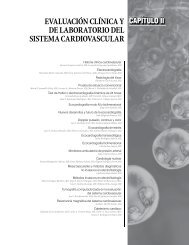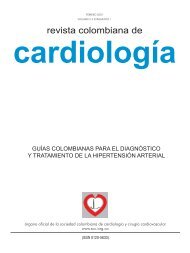Descargar - Scc
Descargar - Scc
Descargar - Scc
Create successful ePaper yourself
Turn your PDF publications into a flip-book with our unique Google optimized e-Paper software.
11. Karpanou E, Vyssoulis GP, Psichogios A et al. Regression of left<br />
ventricular hypertrophy results in improvement of QT dispersion<br />
in patients with hypertension. Am Heart J 1998; 136: 765-8.<br />
12. Struthers A, Davidson N, Naas A et al. QT dispersion and triplevessel<br />
coronary disease. Lancet 1997; 349: 1174-5.<br />
13. Bonnar CE, Davie AP, Carvana L et al. QT dispersion in patients<br />
with chronic heart failure: beta blockers are associated with a<br />
reduction in QT dispersion. Heart 1999; 81: 297-302.<br />
14. Naas N, Davidson N, Thompson C et al. QT and QTc are accurate<br />
predictors of cardiac death in newly diagnosed non-insulin<br />
dependent diabetes: cohort study. Br Med J 1998; 316: 745-6.<br />
15. Sheehan J, Perry I, Reilly M et al. QT dispersion, QT maximum and<br />
risk of cardiac death in the Caerphilly Heart Study. Eur J Cardiovasc<br />
Prev Rehab 2004; 11: 63-8.<br />
16. Malik M, CammJ. Mystery of QTc interval dispersion. Am J Cardiol<br />
1997; 79: 785-7.<br />
17. Gold M, Spencer W. T Wave alternans for ventricular arrhythmia<br />
risk stratification. Curr Op Cardiol 2003; 18: 1-5.<br />
18. Pastore J, Girovard S, Laurita et al. Mechanism linking T wave<br />
alternans to the genesis of cardiac fibrillation. Circulation 1999;<br />
99: 1385-94.<br />
19. Kavesh N; Shorofsky S, Sarang S et al. Effect of heart rate on T<br />
wave alternans. J Cardiovasc Electrophysiol 1997; 8: 987-93.<br />
20. Rosenbaum D, Jackson L, Smith J et al. Electrical alternans and<br />
vulnerability to ventricular arrhythmias. N Eng J Med 1994; 330:<br />
235-41.<br />
Manual de métodos diagnósticos en electrofisiología cardiovascular<br />
21. Hohnloser S, Klingenheben T, Li Y et al. T-wave alternans as a tool<br />
for risk stratification in patients with malignant arrhythmias:<br />
prospective comparison with conventional risk markers. J<br />
Cardiovasc Electrophysiol 1998; 9: 1258-8.<br />
22. Klingenheben T, Zabel M, D’Agostino R et al. Predictive value of<br />
T-wave alternans for arrhythmic events in patients with congestive<br />
heart failure. Lancet 2000; 356: 651-2.<br />
23. Ikeda T, Sakata T, Takami M et al. Combined assessment of T wave<br />
alternans and late potentials used to predict arrhythmic events<br />
after myocardial infarction: a prospective study. J Am Coll Cardiol<br />
2000; 35: 722-30.<br />
24. Moss AJ, Zareba W, Hall W et al. Prophylactic implantation of a<br />
defibrillator in patients with myocardial infarction and reduced<br />
ejection fraction. N Engl J Med 2002; 346: 877-83.<br />
25. Bloomfield D, Steinman R, Pearila N et al. Microvolt T-wave<br />
alternans distinguishes between patients likely and patients<br />
not likely to benefit from implanted cardiac defibrillator<br />
therapy: a solution to the multicenter automatic defibrillator<br />
implantation trial (MADIT II) conundrum. Circulation 2004;<br />
110: 1885-9.<br />
26. Muller J, Tofler G, Stone P. Circadian variation and triggers of onset<br />
of acute cardiovascular disease. Circulation 1989; 79: 733-43.<br />
27. Guo Y, Stein P. Circadian rhythm in the cardiovascular system:<br />
chronocardiology. Am Heart J 2003; 145: 779-86.<br />
111




